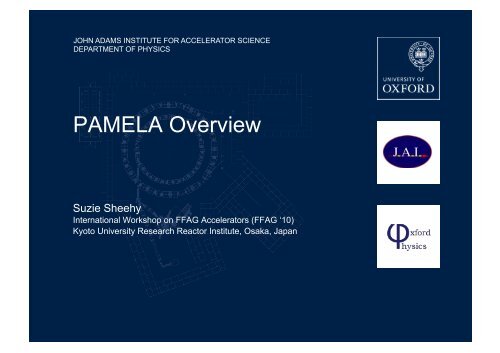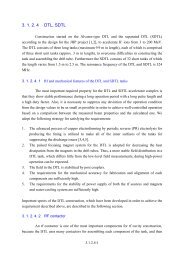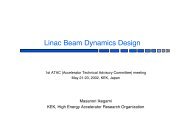PAMELA Overview
PAMELA Overview
PAMELA Overview
Create successful ePaper yourself
Turn your PDF publications into a flip-book with our unique Google optimized e-Paper software.
JOHN ADAMS INSTITUTE FOR ACCELERATOR SCIENCE<br />
DEPARTMENT OF PHYSICS<br />
<strong>PAMELA</strong> <strong>Overview</strong><br />
Suzie Sheehy<br />
International Workshop on FFAG Accelerators (FFAG ‘10)<br />
Kyoto University Research Reactor Institute, Osaka, Japan
Outline<br />
! <strong>Overview</strong> of <strong>PAMELA</strong> project<br />
! Clinical requirements<br />
! Injection and ion sources<br />
! Lattice design & performance<br />
! Magnet design<br />
! RF design<br />
! Beam transport & gantry<br />
! Summary<br />
October 28, 2010<br />
1
<strong>Overview</strong><br />
<strong>PAMELA</strong>: Particle Accelerator for MEdicaL Applications<br />
One of 3 work packages of the CONFORM collaboration<br />
Aim: “to design a prototype proton/carbon ion ns-FFAG<br />
accelerator for charged particle therapy”<br />
Other work packages:<br />
! EMMA (Electron Model of Many Applications)<br />
! Applications (ADSR, particle therapy, radioisotopes etc…)<br />
October 28, 2010<br />
2
Oxford (JAI, Gray, PTCRi)<br />
John Cobb , Bleddyn Jones, Ken Peach,<br />
Suzie Sheehy, Holger Witte , Takeichiro<br />
Yokoi, Mark Hill, Boris Vojnovic + others<br />
Brunel University<br />
Richard Fenning, Akram Khan<br />
Imperial College London<br />
Morteza Aslaninajad, Matt Easton ,<br />
Jaroslaw Pasternak, Juergen Pozimski<br />
STFC/ASTeC/RAL, STFC/DL<br />
Elwyn Baynham, Neil Bliss, Rob<br />
Edgecock, Ian Gardner, David Kelliher ,<br />
Neil Marks , Shinji Machida , Peter<br />
McIntosh, Chris Prior, Susan Smith<br />
Collaboration in UK<br />
Lattice Design<br />
Injection<br />
Extraction<br />
Magnet Design<br />
Medical Requirements<br />
RF<br />
Gantry<br />
Beam transport<br />
Front end<br />
Injection line<br />
Ion sources<br />
Engineering solutions<br />
October 28, 2010<br />
3
Doses for treatment<br />
Proton<br />
Courtesy of T.Okumura (Tsukuba univ.)<br />
Proton: 1~7GyE (Tsukuba Univ, Japan)<br />
radio-sensitive tissues : 1 - 2 GyE<br />
non radio-sensitive tissues : 3 – 7 GyE<br />
Carbon<br />
Low radiosensitive tissue<br />
(lung, liver etc)<br />
high radiosensitive tissue<br />
(brain, perif. of digestive canal etc)<br />
Report by ANTM (Japan,2002)<br />
Carbon: 2~12GyE (NIRS,Japan)<br />
radio-sensitive tissues :2 – 4 GyE<br />
non radio-sensitive tissues :4 – 12 GyE<br />
October 28, 2010<br />
Page 4
Clinical Requirements – dose control<br />
In dose field formation: uniformity and tolerance are important<br />
** SOBP is not necessarily the ideal dose field in spot scanning<br />
Slide thanks to T. Yokoi, <strong>PAMELA</strong> Design Review 2010<br />
October 28, 2010<br />
Page 5
Clinical Requirements<br />
&'!$()*!$+%,-))$'!%<br />
FFAG%<br />
!"#$%<br />
Step size controls dose (injection)%<br />
Slide thanks to T. Yokoi, <strong>PAMELA</strong> Design Review 2010<br />
To achieve Intensity Modulated Particle Therapy:<br />
! multi-beam painting with small bunch intensity<br />
! simple system, but high repetition rate<br />
Rescanning: ~ 5 may be needed to achieve good uniformity (multi-bunch)<br />
Proton: 0.2nA/GyE ! 0.05nA~0.4(1.4)nA (Carbon divide by 36) for 1L<br />
Beam position reproducibility of 0.2 mm (achieved at PSI)<br />
Scanning speed > 100 Voxel/sec<br />
Beam size 4 mm – 10 mm FWHM (variable)<br />
Facility lifetime > 20 years -> Flexibility is crucial!<br />
October 28, 2010<br />
Page 6
Accelerator Challenges<br />
Clinical requirements translate to:<br />
! Variable energy extraction<br />
! 1 kHz repetition rate<br />
! Small accelerator footprint<br />
We also want:<br />
! Small(ish) aperture (scaling FFAG > 1m!)<br />
! Avoid crossing harmful resonances (linear ns-FFAG)<br />
October 28, 2010<br />
7
Injector and Ion Sources<br />
ECR: ECRIS<br />
Hypernanogun<br />
We need 0.6 !A Carbon 6 +.<br />
ECRIS can produce 1 !A Carbon 6 + => use this directly!<br />
Slide thanks to M. Aslaninejad, <strong>PAMELA</strong> Design Review 2010<br />
Could use<br />
C4+ or C6+<br />
October 28, 2010<br />
Page 8
n<br />
RFQ and IH/CH linac<br />
E (keV/u) ~ 600<br />
RFQ<br />
Transmission: 97%<br />
Mean energy: ~600 keV/u<br />
Frequency: 280 MHz<br />
Length: 3.56m / 800 cells<br />
Based on scaled version of<br />
FETS design<br />
Slide thanks to M. Easton & M. Aslaninejad, <strong>PAMELA</strong> Design Review 2010<br />
Modeled in<br />
COMSOL<br />
Drift tubes mounted on alternating sides.<br />
• Pi mode -> enhanced transit-time factor<br />
• Compact drift tube -> very small capacitance<br />
• Higher Shunt Impedance<br />
IH structure: shown, TE_110, Beta=0.1<br />
CH structure: inter-digital fingers rotated by 90 deg.,<br />
TE_210, Beta=0.1 to 0.5<br />
October 28, 2010<br />
Page 9
Injection into the ring<br />
Slide thanks to M. Aslaninejad, <strong>PAMELA</strong> Design Review 2010<br />
A possible layout of cyclotron<br />
inside the first ring% Beta functions of injection line%<br />
October 28, 2010<br />
Page 10
Injector and Ion Sources<br />
• Pamela injection system is under development and substantial progress has been made<br />
• The specification for <strong>PAMELA</strong> operation is compatible with C+6 intensities<br />
• Detailed matching of beam from 30 MeV proton cyclotron has been studied.<br />
• Space Charge is not an issue.<br />
• Work on the RFQ is progressing well.<br />
• Work on IH/CH structure, progressing.<br />
Slide thanks to M. Aslaninejad, <strong>PAMELA</strong> Design Review 2010<br />
October 28, 2010<br />
Page 11
Lattice Design<br />
Aim: Minimise tune variation,<br />
retain small orbit excursion +<br />
hopefully increase long drift<br />
section.<br />
Start with scaling FFAG, FDF<br />
focusing<br />
Break scaling law<br />
1. Truncate expansion of<br />
scaling law<br />
2. Make magnets rectangular<br />
3. Align on straight line<br />
Use 2 nd stability region of Hill’s<br />
equation<br />
October 28, 2010<br />
Page 12
Lattice Design – Energies/rigidities<br />
! 2 ring solution<br />
! Could be concentric to reduce footprint<br />
Particle H+ C6+<br />
Ring 1 inj 1 ref 1 extr 1 inj 1 ref 1 extr<br />
2 inj<br />
2 ref 2 extr<br />
Kin. En./u [MeV] 30.95 118.38 250 7.8394 30.977 68.357 208.749 400<br />
B! [Tm] 0.811 1.621 2.432 0.811 1.621 2.432 4.401 6.370<br />
October 28, 2010<br />
Page 13
Lattice Design<br />
!"#$%&%% !"#$%'%<br />
()*#%!*+",-%./0% !"#$%& '"(&<br />
1)22-% %#& %#&<br />
3*45"#$%6*4789% )"*+& )"!$&<br />
:")2+%"#+);
Lattice Performance<br />
For both the proton and carbon rings:<br />
! Not sensitive to alignment errors<br />
! Total machine tunes within half an integer – no major<br />
resonance crossing<br />
! Dynamic aperture > 50 " mm mrad (normalised)<br />
! Meets all the requirements<br />
5/10/10<br />
567896:;/7?@
Magnet Design<br />
• Magnet Technology Challenges<br />
– Length restriction<br />
– Maximum field (4.25T)<br />
– Combined function magnet (up to decapole)<br />
– Required bore<br />
(>250 mm)<br />
– Field quality: better than 1x10 -3<br />
• Approach: Double-helix coils<br />
Slide thanks to H. Witte, <strong>PAMELA</strong> Design Review 2010<br />
Combined function magnet<br />
56.7% Dipole<br />
30.6% Quadrupole<br />
9.7% Sextupole<br />
2.5% Octupole<br />
0.5% Decapole<br />
October 28, 2010<br />
Page 16
Magnet Design – 3D tracking<br />
• Tracking: Unwanted field components<br />
• Patent Nov. 2009<br />
• 3D field maps have been tracked in ZGOUBI.<br />
Adjusted Original tunes tunes…<br />
Slide thanks to H. Witte, <strong>PAMELA</strong> Design Review 2010<br />
October 28, 2010<br />
Page 17
Magnet Design<br />
• Aim: scalable manufacturing<br />
process<br />
– Grooves in flat sheet<br />
– Precision rolling<br />
• Alignment system<br />
– Alignment pins<br />
– Key system<br />
• Photo etching<br />
• First quotations<br />
• Neil Bliss, Shrikant Pattalwar,<br />
Thomas Jones, Jonathan Strachan,<br />
Holger Witte<br />
Slide thanks to H. Witte, <strong>PAMELA</strong> Design Review 2010<br />
October 28, 2010<br />
Page 18
Proposal: Helical Test Coil<br />
! Dipole (no higher field components)<br />
! Geometry<br />
! Length: 217.4 mm<br />
! Inner radius: 50 mm<br />
! Outer radius: 75 mm<br />
! Gap between layers: 5 mm<br />
! Tilt angle: 60 degrees<br />
! 25 turns per layer<br />
! ‘Wire’: 5.3x2.5 mm 2<br />
! Pitch: 6.3 mm<br />
In process of building a demonstrator – should be ready in a<br />
‘couple of weeks’ – H. Witte<br />
Rapid prototyping model – photo (27/10/10, 11:53pm)<br />
Slide thanks to H. Witte<br />
DH 1<br />
DH 2<br />
October 28, 2010<br />
Page 19
Cryostat<br />
Demountable turret<br />
allows upgrade to<br />
recondensing option<br />
Outer vessel<br />
Magnet support structure<br />
Inner radiation shield<br />
Liquid nitrogen reservoir<br />
Slide thanks to H. Witte, <strong>PAMELA</strong> Design Review 2010<br />
Support Ribs<br />
Liquid helium reservoir<br />
Relief valve assembly<br />
80k Radiation<br />
Shielding<br />
Helium Vessel<br />
Combined function<br />
Magnet<br />
October 28, 2010<br />
Page 20
Injection/Extraction<br />
• Extraction kicker proton ring = injection kicker carbon<br />
• Vertical injection & extraction<br />
3D model kicker for proton lattice<br />
• Arbitrary ferrite (B sat=300 mT)<br />
• Length: 1 m<br />
• Current sheets: 1 mm thickness<br />
• Current densities:<br />
– Carbon: 167 A/mm 2<br />
– Proton: 55.55 A/mm 2<br />
• Magnetic Energy 16/150 J<br />
PFN<br />
• Conceptual design (approved by CERN)<br />
• Module concept (<strong>PAMELA</strong>, PRISM, IDS)<br />
Slide thanks to H. Witte, <strong>PAMELA</strong> Design Review 2010<br />
Kicker#1 Septum<br />
FDF FDF<br />
@kicker<br />
septum<br />
CO @septum<br />
October 28, 2010<br />
Page 21
Proton lattice septum<br />
! Challenges<br />
! Large aperture<br />
! Stray field<br />
! 4T peak field required<br />
! Variable energy extraction<br />
! Field needs to vary<br />
! Superconducting FFAG septum<br />
! Nb 3 Sn<br />
Slide thanks to H. Witte, <strong>PAMELA</strong> Design Review 2010<br />
October 28, 2010<br />
Page 22
RF Design<br />
RING 1<br />
Protons<br />
RING 1<br />
C6+<br />
Harmonic 10 17 10<br />
RING 2<br />
C6+<br />
Low rf (MHz) 19.16 16.69 19.21<br />
High rf (MHz) 45.64 45.80 39.10<br />
Frequency swing 2.446 2.818 2.035<br />
Voltage per gap 6-15 kV 6-15 kV 6-15 kV<br />
No. of 2 gap cavs 8 8 8<br />
Slide thanks to I. Gardner, <strong>PAMELA</strong> Design Review 2010<br />
Voltage per turn 96-240 kV 96-240 kV 96-240 kV<br />
Accel. time 0.4 ms 0.44 ms 1.7 ms<br />
October 28, 2010<br />
Page 23
RF Design<br />
! ASSUMING Q ~ 60<br />
• RF Power per gap 10 – 20 kW<br />
• RF Power per 2 gap cavity 20 – 40 kW<br />
• Mean RF Power for 8 cavities ~240 kW<br />
Slide thanks to I. Gardner, <strong>PAMELA</strong> Design Review 2010<br />
Other ideas: Harmonic Number Jump systems (HNJ), Induction Cavities, Magnetic Alloy loaded<br />
cavities (MA), Drift tubes with ferrite resonators, Multiple fixed frequency cavities…<br />
October 28, 2010<br />
Page 24
Beam Transport<br />
! Many options available<br />
! Slowest part of system will<br />
be magnet changes for<br />
scanning & any physical<br />
movement – want to<br />
minimise<br />
! Hope to have full FFAG<br />
transport & gantry<br />
! FDDF configuration<br />
! Repeated cell structure is 1.6m<br />
in length<br />
! Also: dispersion suppressor<br />
sections<br />
See: S. Machida, R. Fenning, “Beam transport line with scaling fixed<br />
field alternating gradient type magnets”, Phys. Rev. ST. Accel.<br />
Beams, 13, 084001 (2010).<br />
Slide thanks to R. Fenning, <strong>PAMELA</strong> Design Review 2010<br />
Normal cell Dispersion suppressor<br />
October 28, 2010<br />
Page 25
Treatment Gantry<br />
Slide thanks to R. Fenning, <strong>PAMELA</strong> Design Review 2010<br />
! Ongoing work – initial design by R. Fenning for proton gantry<br />
! Lots of ideas – discussions welcome! (T.Yokoi’s talk)<br />
October 28, 2010<br />
Page 26
Layout ?<br />
Slide thanks to T. Jones, Daresbury Lab (STFC)<br />
October 28, 2010<br />
Page 27
Where are we now?<br />
! Final Design Review was October 4-7 th 2010, Oxford<br />
! Final design report being written (due January 2011)<br />
! Need prototyping of:<br />
! Main ring magnets, kicker and septum magnets<br />
! RF<br />
! Ion source<br />
! Funds/collaborators sought!<br />
! PTCRi – research: optimise treatment & minimise damage<br />
October 28, 2010<br />
Page 28
Thanks for your attention.<br />
Oxford (JAI, Gray, PTCRi)<br />
John Cobb , Bleddyn Jones, Ken Peach,<br />
Suzie Sheehy, Holger Witte , Takeichiro<br />
Yokoi, Mark Hill, Boris Vojnovic + others<br />
Imperial College London<br />
Morteza Aslaninajad, Matt Easton ,<br />
Jaroslaw Pasternak, Juergen Pozimski<br />
Brunel University<br />
Richard Fenning, Akram Khan<br />
STFC/ASTeC/RAL, STFC/DL<br />
Elwyn Baynham, Neil Bliss, Rob<br />
Edgecock, Ian Gardner, David Kelliher ,<br />
Neil Marks , Shinji Machida , Peter<br />
McIntosh, Chris Prior, Susan Smith<br />
Please refer to the forthcoming <strong>PAMELA</strong> Design<br />
Report for detailed information.<br />
October 28, 2010<br />
Page 29





